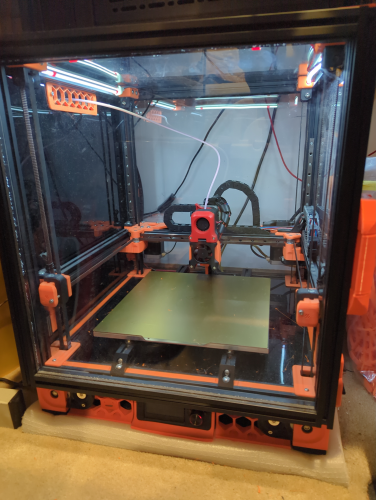Stats
Serial: Voron V2.4809
Cereal: Reeses Puffs
Controller: Pi Zero 2 W
Firmware: Klipper Mainsail
MCU: BTT Octopus Pro
Build Volume: 250x250x250mm
Klipper Plugins
KAMP purge line
Misc Hardware Mods
Clicky-Clack Fridge Door
Rotated back panel
Slot covers
LCD backlight bleed tape
Aitonina

Outdated photo
Future Upgrades
Bed alignment pins
Belt tension test
Door switch for lights
Fix cracked pieces (there are many)
GT1.5 belt swap
IDEX (Flydex?)
BIGTREETECH KNOMI
Name plate
Nevermore Filter
Nozzle Wiper
Physical pause print button
USB port (print from USB)
Printer currently out of commission 🙁
Toolhead upgrade in progress…
Dragon Burner Toolhead
0.4mm Bambu X1C Hotend
Orbiter V2.0 Extruder
Orbiter Smart Sensor
Orbitool O2 Toolboard
ZeroClick Probe (bed dock by me)
Tighter X Carriage (by me)
X Endstop Hitter (by me)
Rejected Mods
Quick release panels (too fiddly; how often do people actually take them off?)
Mods Designed by Me
LED light strips
Orbitool USB double DIN mount
Piezo buzzer
Removed RJ45 Jack
Rigid LCD skirt
Side power switch
TF card skirt badge
Some of my designs are on Printables
(I’ll clean it up later)
Modifications in Depth
Dragon Burner Tool Head
My printer doesn’t print too good. I suspect it has something to do with the ungodly number of times I’ve sent it crashing into the print bed, but I can’t be too sure. The Afterburner my printer was original built with is made up of a combination of printed and injection molded parts which came with my Voron kit.
[Under construction…]
Black & Orange
The 3D printed parts of my printer are in eSun ABS+ (or was it normal ABS?) orange and black. I really love the aesthetic of Prusa printers and wanted to recreate it.
I Spun it Right Round
My printer currently sits under a table, up against a wall. This makes it really annoying to change spools or reach around for the power switch. That’s why the back panel is now on the left and the power switch is on the front right side skirt A. I can reach it with my foot.
Shut the Front Door
The stock V2 doors are held together with hopes and dreams. I am genuinely perplexed as to how other people in the community get them to work. They’re flimsy and they don’t seal well. They’re the only part of the stock build structurally held together with double sided tape.
When I came across the Clicky-Clack Fridge Door, browsing popular Voron mods (but not on Voron mods), I immediately knew those stock doors were coming off. I considered self-sourcing the complete build but I calculated it was much more economical to buy a kit from Aliexpress (not to mention I don’t have a clean way of cutting aluminum extrusions yet). Almost all available kits are sized for the 300mm and 350mm variants but I did manage to find a vendor who sold 250mm kits. However, they were unreasonably expensive if the acrylic panels were included, so I ordered the panels separately. One pro tip for self-sourcing acrylic panels on Aliexpress is that sellers are more than happy to cut panels down to whatever dimensions you want at no extra cost. Just message them the dimensions you need, they’ll charge you for the stock material and send you the perfect size panel in the mail.
The door can be satisfyingly slammed shut like a mini fridge now, and I’m really happy. It does look a little odd having an extrusion’s worth of door sticking out the front but the door is infinitely better than the stock one.
When I first installed the door, it shut very well but over time, the latch started getting caught. I thought it was due to the PLA parts (I don’t have an air filter to print ABS yet) warping over time, but I later debugged it as the extrusions coming out of alignment. It uses the same blind joints as the rest of the printer, but I realized that those don’t bend because every corner of the printer is reinforced with 3D printed parts. Adding the panel corner clips to the door fixed all the issues I had with the door.
Another issue I had with the door is the panel mounting strips falling off. I assume it’s because the ones that came with the kit were too thin. I double sided them in, but I think the huge line of micro fractures in the panel is due to me slamming the door and the panel rattling inside. I can’t feel anything rubbing my finger along the edge, so I think it’s just superficial. In any case, it’s not structural / load bearing; I’m sure she’ll be right.
Alright KAMPers
Every 3D printer should use adaptive bed meshing. I have no clue why Bambu and Prusa printers still waste time probing their entire bed instead of only the actual print area. It drives me mad watching a printed take 25 measurements when they really only need 9 (for most of the smaller prints I need). Klipper Adaptive Meshing & Purging (KAMP) does just that and more.
The adaptive bed meshing of KAMP has been integrated into mainline Klipper, but not the adaptive purging (at time of writing, Nov 2025). Adaptive purge uses a very short line (or Voron logo) right next to the print instead of always in the same spot. It uses very little material and eliminates the need for skirts or bigger purges and it minimizes the stringing you’d get from purging along the side of the print bed and stretching a filament strand all the way over to the start of a print.
That’s why I have the KAMP plugin installed.
Red, Green & Blue
Personally, RGB on toolheads or chamber lighting feels a bit tacky. I mean if you want to go for that gaming computer look for your printer, then go for it, but I prefer to give my machine a more utilitarian look. But the stock BTT Mini12864 screen comes with 3 RGB LEDs built in and I wanted to get the most out of them.
LED index 1 and 2 shine through the control knob, while index 3 is a backlight for the LCD screen. While I was trying to configure them and after a bit of confusion, I figured out that the backlight really bleeds into the knob. I recommend fellow owners to put a bit of black electrical tape between the side of the screen and the knob like I did. Besides that, I found that setting the 2 knob LEDs to different colors wasn’t very readable so I made the LED macros treat them as one.
I configured the screen and knob colors to indicate the current state of the machine. Note that, given the same RGB values, the knob and screen colors can appear different.
| Color | RGB | Screen Meaning | Knob Meaning |
|---|---|---|---|
| Green | R=0 G=1 B=0 | Ready to print | Ready to print |
| Orange | R=1 G=1 B=0 | Printing Unloading filament | Printing |
| Blue | R=0 G=1 B=1 | Homing | XYZ Homing |
| Red | R=1 G=0 B=0 | Paused Quad gantry level | Bed mesh calibration Paused Quad gantry level Unloading filament |
I also configured all LEDs to turn off when the printer is idle.
Buzz Off
The BTT Octopus Pro has a buzzer built in but I haven’t found a way to interface with it in Klipper. I had a few piezo buzzers lying around and an empty fan pin on the control board, so I added a buzzer to my printer.
I configured the buzzer to audibly let me know the state of the machine and it’s been such a quality of life feature.
| Buzzer Pattern | Meaning |
|---|---|
| 1 beep | Filament unload complete |
| 2 beeps | Print started Print resumed |
| 3 beeps | Print cancelled Print completed |
| 1 long beep | Print paused Temperature reached |
Wifi Password Shenanigans
My dad likes to change the wifi password pretty often (I’m still living with parents at time of writing, Nov 2025). The way to change the wifi password on a Raspberry Pi (without connecting it to a full set of peripherals) is through the TF (microSD) card. My computer tower sits on top of my printer, so I have to pull out all the cables in my computer, put my computer away, pull out my printer, flip it upside down and unscrew the bottom panel to pull out the TF card.
After the first 3 times, I decided to get an extension cable and route it into a skirt badge on the front of my printer. Annoyingly, the skirts have a curve to them so I can’t make a full hexagon shape. The female end of the cable only just fits the skirt holes so designing a mount was a challenge. I’m not completely happy with it but I’ll publish a cleaned up model in the future.
